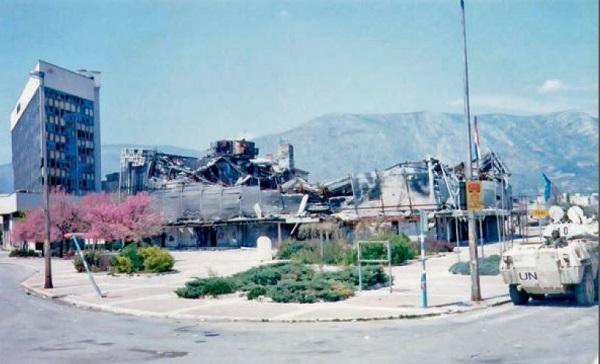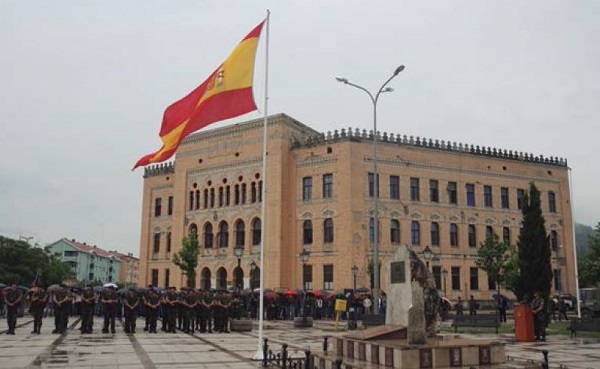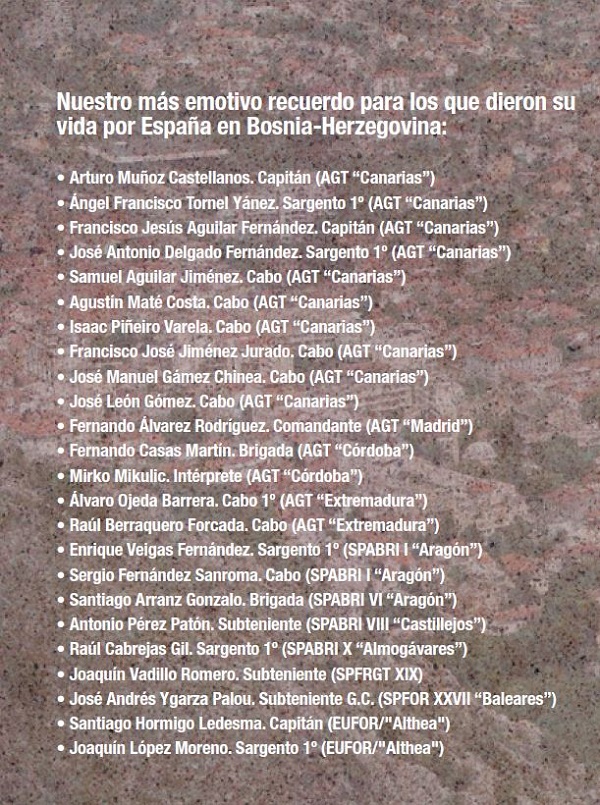- Home
- Feature Articles
- 25 años en Bosnia-Herzegovina
25 years in Bosnia-Herzegovina
Monday, January 22, 2018
Number: 57

Cover of the Special Edition of 25 years in Bosnia-Herzegovina. Photo:DECET
In November it was reached a quarter of century since the Spanish troops started a deployment in Bosnia-Herzegovina (B-H), which tried to contribute and pacify the "the war beast", and overall, to protect the weakest ones from its swipe.
In these 25 years, they have varied their emblems- first, they were under the UN's flag, afterwards under the NATO's, and finally, under the European Union's- but they have always been proud of dressing the Spanish uniform and they have protected the civilian population from the ravages of war, giving the best that they have, some of them even their lifes...
The beginning of the disintegrationWith Tito's death, in 1980, the old issues revived. Step by step the situation became worse and the process of independance of the different republics (B-H, Croatia, Macedon, Montenegro, Serbia and Slovenia) began taking shape. In 1991, the Yugoslavian population was formed by 24 millions of inhabitants; in some regions it was very homogeneous etchnically speaking, whilst in others, it was not.

Mostar Centre in 1994. Photo:DECET
The 14th of September the United Nations Protection Force's mission (UNPROFOR) for the old Yugoslavia, was extended to B-H. Here, it is framed the mission of the Spanish soldiers, in an environment of tense calm sometimes, and opened hostility in other cases.For our country, this deployment constituted a challenge which was not expected at all. Even thought Spain was a member of the NATO since 1982, it had not participated completely in any international conflict forming an unit.
The only relevant mission had been, in between April and June of 1991, in Iraq. In this occassion, the Paratrooper Brigade and the Airmobile Forces of the Spanish Army, together with other commands and units, had been part of the "Provide Comfort" operation (humanitarian aid), sponsored by the UN and conducted by the NATO, in Iraqi Kurdistán. It had also participated in different missions sending soldiers as observers of peace... but nothing like this.

Plaza de España in Mostar. Photo: DECET
At the beginning of September, the Legion's Company with base in Fuerteventura travelled by Hercules aircraft to Almería, to what it is designated now as phase of concentration. There, the companies of Ronda and Melilla were joined, constituting the Tactical Group "Málaga", whose front was headed by colonel Zorzo. It was the beginning of the Spanish mission in B-H. Something unprecedented needed to be conducted in our country. Its main aim was to open a safe route for the entrance of humanitarian aid to Sarajevo, following the flowing water course of the Neretva. A route, which, precisely, had been abandoned by other convoys because of the risk to which they were exposed, due to the fact that it was placed in a line of conflict between the Serbian and Croatian people.
The chief of the recently created Rapid Action Force (FAR in Spanish), general Agustín Muñoz-Grandes, shaped Group "Málaga" with men and women belonging to the different units arriving to Almería. They should start a specific group for the new mission, formed by different units and commands, coming from various assignments, and train the personnel concerning the use of the huge diversity of materials and vehicles (such as the BMR). "It was not easy to coordinate the personnel of 61 different units: Infatry, Cavalry, Artillery, Engineers, Quartermaster Corps, Specialits, the Department of Health..., but it was done. Working day and night, it was done", admits colonel Zorzo in the mentioned book "Misión Bosnia (25 años)".

Losses in mission Bosnia-Herzegovina
ARMY UNITS
- Araba Álava |
- Albacete |
- Alicante |
- Almería |
- Asturias |
- Ávila |
- Badajoz |
- Barcelona |
- Burgos |
- Cáceres |
- Cádiz |
- Cantabria |
- Castellón |
- Ceuta |
- Ciudad Real |
- Córdoba |
- A Coruña |
- Cuenca |
- Girona |
- Granada |
- Guadalajara |
- Gipuzkoa |
- Huelva |
- Huesca |
- Islas Baleares |
- Jaén |
- León |
- Lleida |
- Lugo |
- Madrid |
- Málaga |
- Melilla |
- Murcia |
- Navarra |
- Ourense |
- Palencia |
- Las Palmas |
- Pontevedra |
- La Rioja |
- Salamanca |
- Segovia |
- Sevilla |
- Soria |
- Tarragona |
- Santa Cruz de Tenerife |
- Teruel |
- Toledo |
- Valencia |
- Valladolid |
- Bizkaia |
- Zamora |
- Zaragoza



